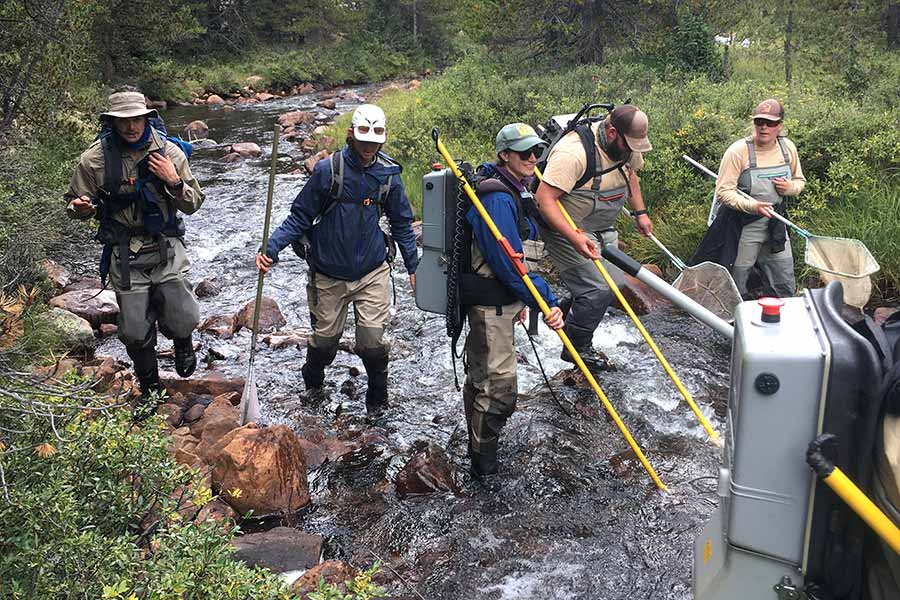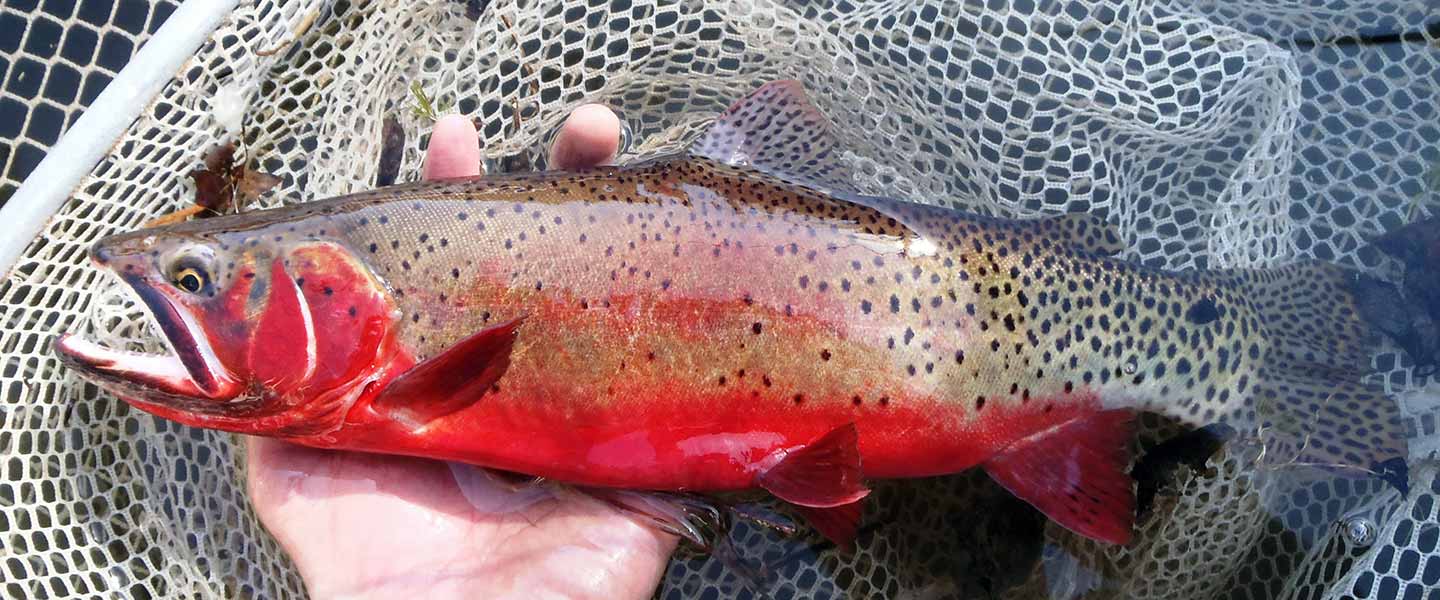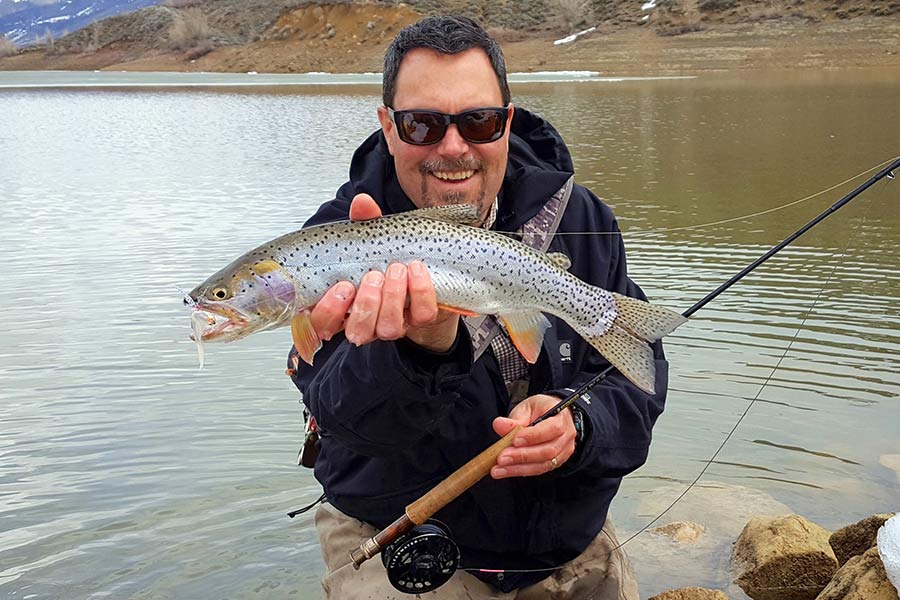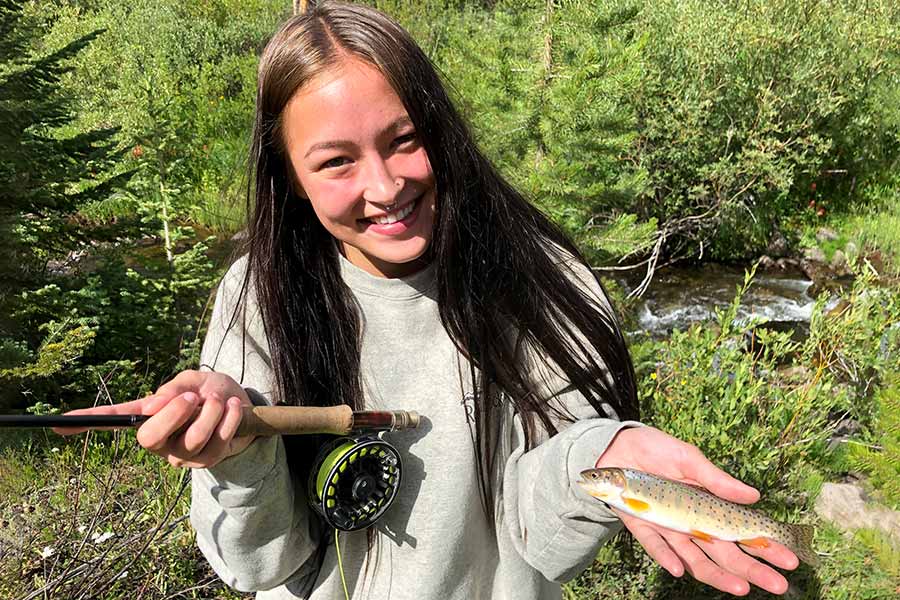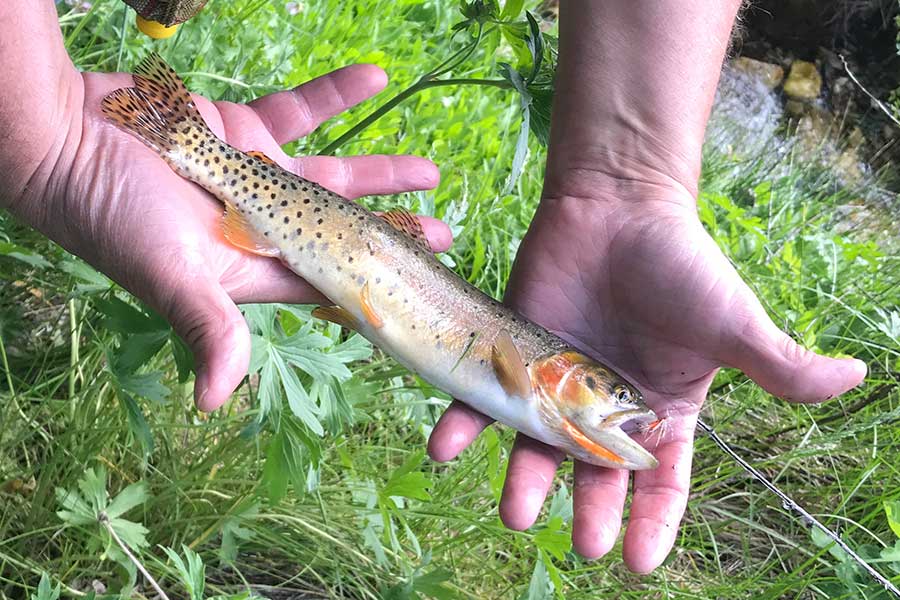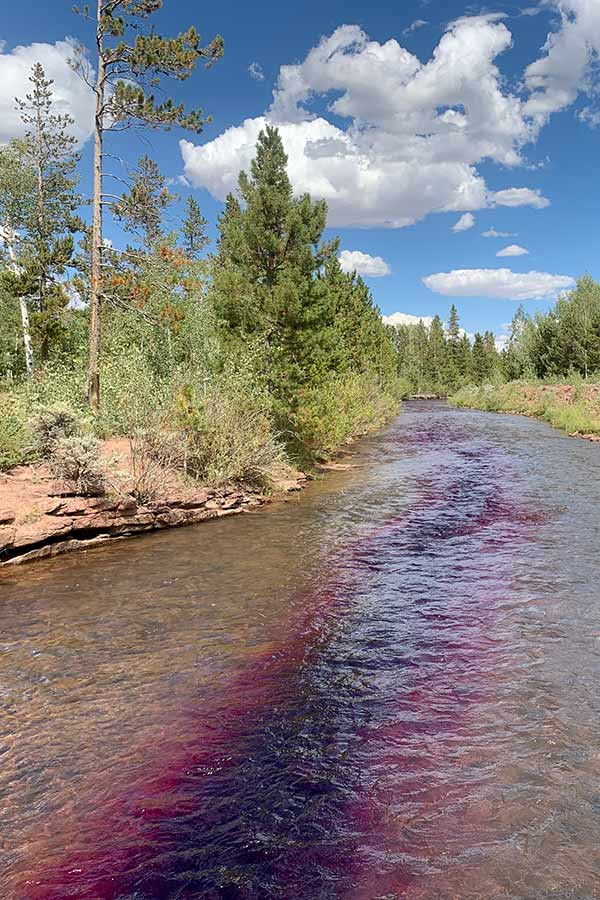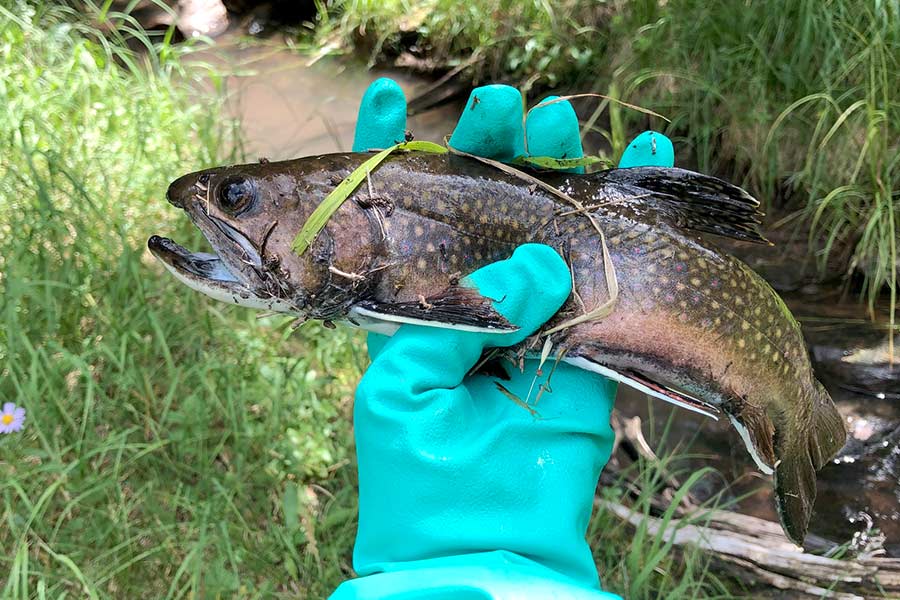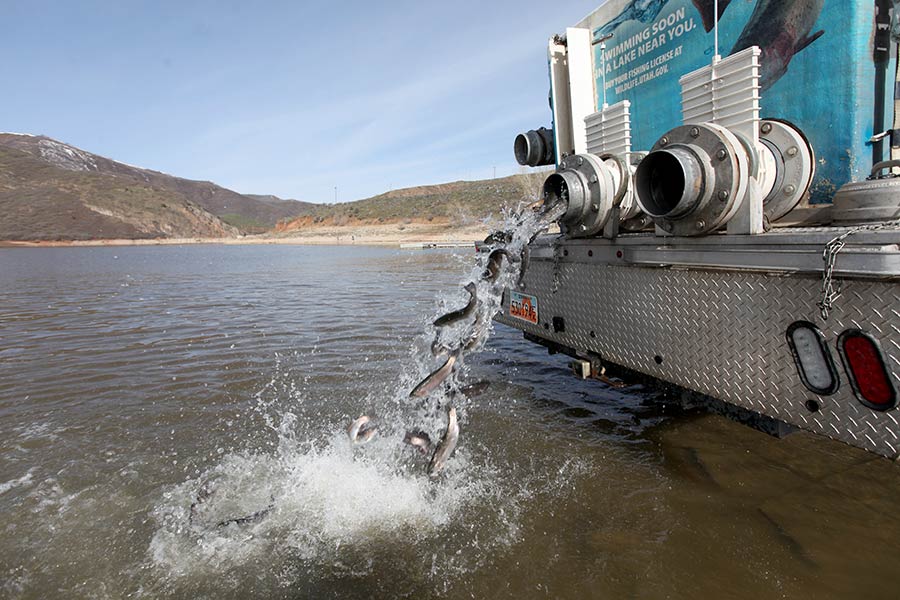Cutthroat trout Q&A: Answering your questions about cutthroat trout restoration in Utah
Learn more about Utah's native cutthroat trout conservation efforts and our fisheries management plans for other trout species
Randy Oplinger
DWR Assistant Aquatic Section Chief
Did you know that cutthroat trout are the only trout species native to Utah? There are four subspecies of cutthroat trout — Bear River, Bonneville, Colorado River and Yellowstone — distributed throughout the state. In the late 1800s, other nonnative trout species such as brook, brown and rainbow trout were introduced in Utah. These fish were brought here because people wanted to establish additional angling opportunities, and bring species of fish to the region that they were familiar with from other parts of the country or even the world.
For over 100 years, the DWR has raised and stocked brook, brown and rainbow trout for Utah anglers. A lot of this stocking has happened in waters that historically held cutthroat trout, and at the time, the impacts on cutthroat trout from stocking these other species were not fully understood. Scientists and anglers now recognize that the widespread presence of nonnative fish have affected not only cutthroat trout populations, but in some areas, have created imbalances that impact other aquatic species and habitat.
It's a complicated balance of fisheries science, public input and habitat conservation that we consider in order to provide both great angler opportunities and quality fisheries for generations to come. Here are answers to some frequently asked questions about why we manage cutthroat trout in Utah and how we do it.
Question: How have nonnative trout impacted cutthroat trout in Utah, and why does this matter?
Answer: Today, we have a greater appreciation of the impacts of nonnative trout on cutthroat trout:
- Brown, brook and rainbow trout can compete with cutthroat trout for food sources and habitat.
- Some of these species feed on cutthroat trout, especially young cutthroat.
- Rainbow trout also have the ability to breed with cutthroat trout, which reduces cutthroat trout genetic integrity.
On top of these new species introductions, other actions — such as habitat alterations and the impacts of urbanization throughout the state — have also negatively affected cutthroat trout.
Unfortunately, a combination of these factors led to a decline in cutthroat trout in Utah. By the 1970s, there were only a handful of identified cutthroat populations in Utah. Cutthroat trout were on the brink of being listed as either a threatened or endangered species, and there have been multiple petitions to list the species under protection of the Endangered Species Act.
However, no Utah subspecies of cutthroat trout have ever been listed as threatened or endangered under the ESA. That is because agencies like the DWR — along with community partners — have worked to implement a number of strategies that help conserve the species.
Question: Why does the DWR do so many cutthroat trout restoration projects?
Answer: Over the past 50 years, the Division has been working to restore cutthroat trout populations to maintain the legacy of cutthroat trout in Utah.
We also want to make sure that cutthroat trout aren't listed as a threatened or endangered species because if a listing occurs, there may be federally mandated actions that could greatly impact anglers and Utah's economy. For example, if cutthroat trout were to be listed as endangered, the DWR may be required to do more cutthroat trout restoration work than is currently planned (and budgeted for). Or, some habitat restoration methods that affect private property owners may be mandated.
Ultimately, it's our goal to ensure that cutthroat trout populations are secure in Utah, and we want to achieve that goal with the minimum impact to anglers and the public.
Question: Does the DWR plan on replacing all brook trout, brown trout and rainbow trout with cutthroat trout?
Answer: No. In fact, when our planned restoration efforts are complete, there will still be significantly more of those nonnative trout populations in Utah than cutthroat trout populations.
Regardless, the restoration of cutthroat trout is well supported by anglers. Here are some things we learned from a 2022 survey of Utah anglers:
- 47% of anglers identified cutthroat trout as one of their most preferred species to catch, and the popularity of cutthroat trout has grown in recent years.
- Anglers recognize that cutthroat are fun to catch. They fight hard when hooked and taste great.
- Brown trout were only slightly more popular, being preferred by 50% of anglers.
- 27% of anglers prefer catching brook trout.
- Rainbow trout are the most popular species to catch, being preferred by 65% of anglers.
- Anglers think there are too few cutthroat trout fishing opportunities in Utah, whereas brown, brook and rainbow trout opportunities were identified as ample.
We recognize that anglers enjoy catching many different fish species, including a variety of native and nonnative sportfish. We can conserve cutthroat trout while also providing anglers the opportunity to catch other species including brook trout, brown trout and rainbow trout. Ultimately, we want to provide species opportunities in proportion to their popularity with anglers. And we're currently in the process of developing a management strategy for all fish species, statewide.
A secondary goal is to create better access by spreading these opportunities at a range of Utah waterbodies, so that every angler in the state has great fishing within driving distance to them.
These strategies will consider species biology and interactions among species to plan for success far into the future. For example, cutthroat and brook trout thrive at higher elevations' conditions. Brown trout do better at lower elevations than cutthroat and brook trout, so most brown trout opportunities will be at lower elevations.
Question: So, what exactly are the DWR's cutthroat trout restoration plans?
Answer: We critically evaluated the populations of each of Utah's four cutthroat trout subspecies and have developed restoration plans for each subspecies.
Our cutthroat management plans are based on objective restoration science, and consider both the number of cutthroat populations conserved and the amount of habitat available (miles of stream) for those cutthroat.
Some things we consider for cutthroat trout restoration efforts:
- Cutthroat are better protected when there are multiple populations because it is unlikely that a catastrophic event such as a wildfire will eliminate multiple population locations.
- Populations are more likely to persist when there is larger amounts of habitat (miles of stream) because more habitat supports a larger number of fish and provides more food and shelter.
- When possible, we try to establish what are known as metapopulations, which are multiple populations that are connected and can move between populations. These metapopulations are beneficial because if one population is lost (for example, during a wildfire) then fish from another connected population can move in and recolonize the stream. Ultimately, metapopulations provide better population security than single, isolated populations.
Also, within the four recognized cutthroat subspecies that are native to Utah, there are genetically unique sub-groups. For example, Colorado River cutthroat trout on the north side of the Uinta Mountains are genetically distinct from those on the south side of the Uinta Mountains. These genetic differences are natural and are the result of the mountains providing a natural barrier that isolates cutthroat trout from the north side of the Uintas from those on the south side. The number of populations of these unique sub-groups and the amount of habitat represented within each group is also considered when restoration plans are developed.
Currently, the DWR has eight cutthroat trout restoration projects planned over the next 10 years. These projects will primarily benefit Bonneville cutthroat trout and Colorado River cutthroat trout, and are spread through northern, southern and southeastern Utah. All planned projects are based in river drainages, and sometimes involve removing fish from connected lakes. We often break projects into multiple phases that are completed over several years, and two to three removal treatments are generally required before cutthroat trout can be restocked. As a result of this, it generally takes at least two years (but more often three) to complete a restoration project.
Any additional restoration efforts beyond the eight projects that are currently planned will be selected on a case-by-case basis. They will only be performed when the projects are led by partner agencies and where angler impacts are anticipated to be minimal; they'll likely be small, located in remote areas and will be implemented in situations where minimal agency effort (and budget) is required. For example, cutthroat trout may be stocked into a small, rarely visited stream after a wildfire naturally removes nonnative fish from the stream.
For now, we have no plans for additional restoration work with Bear River and Yellowstone cutthroat trout. Bear River cutthroat populations are considered secure in Utah. Yellowstone cutthroat trout are the least abundant subspecies native to Utah, but that's largely because the Yellowstone trout native range is restricted to the Raft River Mountains in Utah, and historically they only occupied a handful of streams in Utah. We haven't planned any restoration work on Yellowstone cutthroat because the subspecies is already well represented within its native range in the state.
Regardless of the planned work, cutthroat trout will still not be as abundant as they were historically in Utah. Once the planned restoration projects are completed, we anticipate that:
- Bear River cutthroat trout will occupy a little more than half of the range they occupied before widespread emigrant settlement in Utah.
- Bonneville cutthroat trout will occupy 35% of their historic range.
- Colorado River cutthroat trout are projected to occupy 25% of their historic range once planned restoration efforts are complete.
- Yellowstone cutthroat will occupy a greater proportion of their historic range in Utah than the other cutthroat subspecies.
Question: How does the DWR decide where to restore cutthroat trout?
Answer: We strategically select streams for restoration based upon the ability to provide high quality cutthroat trout habitat, and how much habitat (miles of stream) that a restoration project will provide for cutthroat.
Another consideration is that there always needs to be a barrier at the downstream-most point of the planned project. This barrier prevents fish downstream of the restoration site from migrating back into the restored stream section. This helps ensure that cutthroat are the only trout species in the restored stream. These barriers can either be natural features, such as waterfalls, or manufactured features like dams. When the conditions are suitable, we sometimes install fish barriers if pre-existing barriers are not available.
Once an adequate barrier is in place, the DWR removes all fish from the stream using a compound known as rotenone. This treatment is often used in combination with habitat improvement projects to create an environment where cutthroat can be reintroduced and naturally reproduce without pressure from out-competing species.
Question: What is rotenone and how does it work?
Answer: Rotenone is a natural substance that is found in the seeds, stems and roots of tropical plants in the bean family (jewel vine and lacepod). It has been used by many cultures for thousands of years to kill fish, which were then harvested and eaten. Fisheries managers have been using commercially produced rotenone since the 1930s.
Rotenone kills fish by disrupting the transfer of oxygen from the blood to other parts of the body such as muscles. (Specifically, rotenone inhibits electron transfer during cellular respiration processes.) Rotenone impacts gilled organisms like fish more than other animals because rotenone is easily absorbed from the water into the gills.
Usually, aquatic invertebrates are less affected by rotenone than fish. However, invertebrate populations and immature, gill-breathing frogs, toads and salamanders can be affected by rotenone treatments. Adult, air-breathing frogs, toads and salamanders are less frequently affected. Most often, rotenone is applied in late summer after frogs and toads have metamorphosed from the gill-breathing stage and are therefore not likely to be affected during rotenone treatments.
Invertebrate and amphibian populations normally rebound quickly after a rotenone treatment is completed. In addition to being less affected overall than fish, they typically thrive when fish are absent (because fish feed on these invertebrates and amphibians). Also, the DWR does not apply rotenone to standing water adjacent to streams that do not hold fish. This means that these pockets of water will continue to hold invertebrates and amphibians that recolonize the stream.
Rotenone naturally detoxifies quickly. When water is warm, detoxification can take as little as one day. When scheduling treatments, we take into consideration that detoxification can take several weeks in colder (or deep) water. Also, rotenone readily binds to sediment and organic material in streams, which effectively removes the compound from the water. Sunlight can also accelerate the breakdown of rotenone.
Generally, rotenone will persist in the water for between one and five hours of travel time as it flows downstream. In fact, the time that it persists is low enough that when we apply rotenone, it has to be recharged at several points within the treated stream section. Simply applying rotenone at the upstream-most point and allowing it to flow downstream through the treated section is ineffective because rotenone does not persist at effective concentrations for very long.
Question: Is rotenone dangerous for people?
Answer: The rotenone concentrations applied for our restoration projects are less than 50 parts per billion, which is well below the threshold of what is considered safe for human contact. The EPA has deemed rotenone concentrations of less than 90 parts per billion as safe for human contact, and concentrations less than 40 parts per billion are safe for drinking. And because of the rapid detoxification once rotenone is dispersed into water, actual concentrations within streams are lower than what is introduced at the point application.
Studies have estimated how much water people would have to drink to receive a lethal dose of rotenone, and an adult would have to drink more than 10,000 gallons over a few days to receive a lethal dose at the concentrations applied by the DWR.
We also take many steps to ensure that treatment areas are specifically targeted. When restoring cutthroat trout, we often select remote areas where few people and livestock would come in contact with the chemical during stream treatment. The area around a rotenone treatment is closed for a few days as a precautionary step to ensure public safety, and signs are posted in the area.
Rotenone detoxifies quickly enough that the risk to areas downstream of the treatment site is very low. As an extra precaution, we use a counteractive product — potassium permanganate, commonly used to purify drinking water — to deactivate rotenone in situations where humans or livestock may come in contact with it. We also frequently apply potassium permanganate at the downstream end of the area treated with rotenone to prevent the unnecessary impact to fish below the treated area. Our treatments always comply with all permitting rules, which helps ensure that public safety is considered whenever rotenone is used.
There have been publicized concerns that rotenone exposure could be associated with Parkinson's disease, but studies have not confirmed this link. As a general precaution, DWR staff wear personal protective equipment while applying rotenone and receive special training on how to safely apply rotenone. Public access is restricted in the treatment area until rotenone concentrations subside to safe levels. These steps mean that the risk of being exposed to rotenone during a treatment is essentially eliminated. The American Fisheries Society (a professional society made up of fisheries biologists) has more safety information about rotenone published here.
Question: What happens to the fish that die during rotenone treatments, and isn't this wasteful to just kill them?
Answer: If there are catchable-sized fish in the waterbody we are planning to treat, we typically issue a special regulation change to increase catch limits so anglers can harvest more fish prior to treatment. These regulation changes are posted on our website, on waterbody descriptions at the Fish Utah interactive website and in emailed fishing reports (subscribe here) so that anglers can take advantage of these opportunities.
Fish that die during rotenone treatments are usually left to decompose. (Note: The EPA advises that people do not consume fish that die during a rotenone treatment.) Fish decomposition provides important nutrients that help the fishery in the future. Rotenone does not accumulate in fish and other organisms, so it's not released into the environment as the fish decompose. And fish decompose quickly so it is not likely that the public will see or smell decomposing fish when the treated stream reopens to the public.
Often, the vast majority of fish in a stream die during a rotenone treatment. And the majority of these are juvenile fish that are too small for people to catch. We typically treat the same section of stream two or three times over the period of a couple of years to help ensure that nonnative fish are completely removed before cutthroat trout are restocked.
Question: What are the alternatives to using rotenone?
Answer: Under current guidelines, rotenone is the only chemical that is available and approved for the removal of fish. Unfortunately, rotenone is nonselective, meaning that it removes all species of fish.
Other potential removal methods are either ineffective or under development. For example, studies have shown that anglers are ineffective at reducing the number of fish in a stream. Part of the reason for this is because most fish in a stream are young and are too small for anglers to catch. Similarly, attempts to remove fish using tools such as electrofishing equipment have been ineffective both within Utah and elsewhere in the country. There are emerging tools that are under development that may become effective in the future, but they are not available for use currently.
The DWR prefers to complete all restoration efforts once they have been started because nonnative fish can reinvade a stream if they are not completely eradicated. As a result, the DWR treats a stream segment two to three times with rotenone to ensure that nonnative fish are eradicated. Reinvasion means that the treatment was a failure, and that time and money were wasted performing a treatment.
Luckily, we have had several decades of successfully completing rotenone treatments. Some good examples include the restoration of cutthroat trout into Mill Creek (near Salt Lake City) and Ferron Creek (near Price). Since the 1970s, the DWR has restored dozens of cutthroat populations in hundreds of miles of stream and in many lakes.
Question: How long does it take for good fishing to come back after a rotenone treatment, and how does the DWR manage fisheries with cutthroat trout in the future?
Answer: The DWR usually stocks cutthroat trout back into a restored stream within a few weeks of the last rotenone treatment, and then again annually for three to five years. After that, there is typically enough natural reproduction to allow the fishery to sustain itself without stocking.
We also may continue to stock cutthroat trout if additional time is required to restore the fishery, or if the fishery is heavily used by anglers. Sometimes, it takes several years for fish to grow to a size and to reach sufficient numbers for anglers to have a good experience after a water is restored.
Our fisheries managers will sometimes stock tiger trout into more popular fisheries shortly after the completion of a rotenone treatment. Our hatcheries can produce catchable-sized tiger trout, and the stocking of these fish creates fishing opportunities almost immediately after a rotenone treatment is completed. Tiger trout are sterile — which means they cannot reproduce — and their lack of reproduction means that we can control numbers through stocking and can keep numbers below levels where they can impact cutthroat trout.
Generally, tiger trout are only stocked for a few years after a restoration project is completed. They are progressively replaced by cutthroat trout as the cutthroat grow and begin naturally reproducing. We often continue to stock tiger trout in some high mountain lakes after a rotenone treatment is complete where minimal natural reproduction among cutthroat trout is expected.
Because brook trout, brown trout and rainbow trout can compete, predate or hybridize on cutthroat, we typically do not stock those nonnative species in streams that have been restored with cutthroat trout. However, we sometimes stock sterile variants of these species if there are isolated lakes within a watershed where fish cannot escape and impact cutthroat trout.
Learn more:
- Support cutthroat trout conservation by participating in the Utah Cutthroat Slam
- See what fish have been stocked in your favorite waters
- Sign up to receive email fishing forecasts
- Quiz: How much do you know about fish in Utah?
- Blog post: The strategy and science behind fish stocking
- "Wild" podcast, episode 20: Utah Cutthroat Slam
- "Wild" podcast, episode 31: Fisheries management
- "Wild" podcast, episode 44: Fishing in Utah



